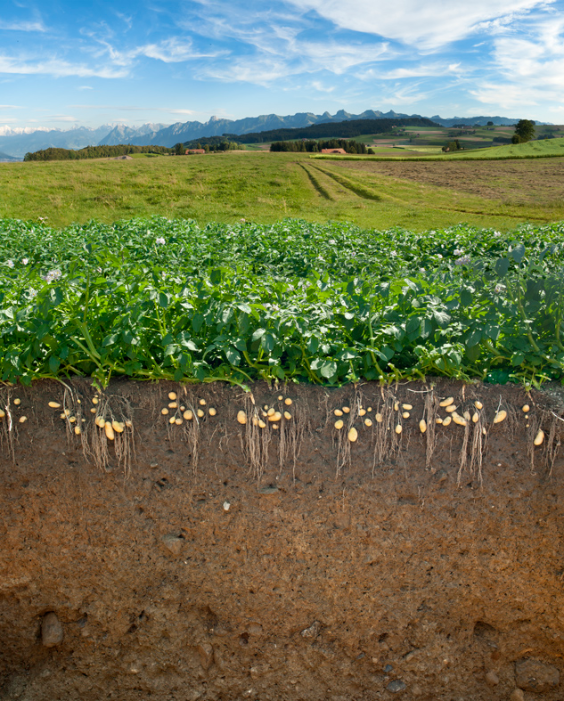Soil is a limited, ecologically and economically valuable non-renewable resource. Along with water and air, it is essential for life.

Soil is the topmost weathering layer of the Earth's crust. It consists of mineral particles, humus, water, air and living organisms. Healthy soil has a well-defined structure. Soil particles are arranged in such a way that large enough spaces, known as pores, form between them. These pores store water and allow air to circulate. They can account for up to 50 percent of the total soil volume.
The soil regulates the natural cycles of water, air, and organic and mineral matter. It filters and purifies water, stores and breaks down substances and is therefore a vital link in the constant flow of energy and matter throughout the Earth's entire ecosystem.
A significant share of this valuable work is performed by billions of organisms that live in the soil. These are mostly inconspicuous plants and animals that are viewed with contempt rather than appreciation. Some of these include bacteria, algae, fungi, worms, springtails, and woodlice, etc. The most obvious example is probably the earthworm. Soil biota are responsible for new soil formation.
The soil's surface and substance also make it a resource for food and fodder production, a source of energy and raw materials, a basis for protection forests and a site for settlements and transport and utility infrastructure. Furthermore, it performs ideal functions as a component of nature and landscapes, as a cultural and geohistorical archive, as a religious site and as a research object.
However, soil can only fulfil most of its ecological and economic functions if its moisture regime and aeration are not disrupted, plants have enough room for their roots, nutrients and soil biota types and quantities are in balance and pollution levels are within tolerable limits for plants and soil organisms.
All human activities affecting the soil must always take into account that it is scarcely possible to generate new soil because soil formation takes a very long time. Soil is an inert medium that takes a long time to respond to exogenous influences, which means that problems are only recognised later and often too late. Soil is the final repository for pollutants, which means that chemical pollution is often irreversible. That is why only structurally intact soil can function properly.
Key points for soil protection in the coming decades
- Knowledge of its crucial role in the ecosystem and its vulnerability is a prerequisite for responsible soil management.
- Precautionary measures must be taken to protect fertile soil - irrespective of its use - from physical, chemical and biological pressures.
- Effective soil protection requires coordinated and, to some extent, long-term observation and monitoring of the soil. This requires consistent, reliable and comprehensive information on the state and vulnerability of soils in Switzerland.
- The soil fulfils vital functions in the ecosystem. For that reason, only sustainable, careful and sparing use - in terms of its surface area, quantity and quality - is permissible.
- Polluted soil that poses a threat to humans, livestock and crops should not be handed down untreated to future generations. It must be at least be remediated to ensure that all risks are removed.
- Like water, air, and forests, soil is a common good, which may be used but not destroyed by its owner. Anyone who uses the soil is also responsible for protecting it.
- Legal standards must be put in place to ensure soil functions i.e. soil fertility.
- Soil protection is a recognised social mission. To carry out this mission effectively and in time, the institutional framework required to ensure effective soil protection needs to be improved and endowed with financial and human resources.
- Soil protection must be executed in a concerted effort of all stakeholders. Close cooperation is essential. Duplication of efforts should be avoided by delegating responsibility on a case by case basis.
- Spatial planning, agriculture and forestry are especially important partners in soil protection. The challenges in soil protection must be tackeled in close cooperation with these partners.
Last modification 24.08.2021





